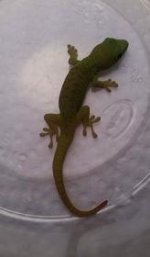TheLastCreature
New member
Hello! So I'm hoping to aquire my first giant day gecko soon, I assume it's only 4ish months old and I'm not new to reptiles in any way but this is a new species for me and I want to make sure I have everything set up properly before purchasing so let me know if I get anything wrong or have any extra tips 
-Mist twice a day
-80-85° temp
-90-95° basking spot
-Super worms(I am terrified of crickets and super worms are the next best thing) 4 days a week (mon, wed, fri, sun) with DGD suplemented with extra calcium 3 days a week (tues,thurs,sat)
-lots of fake plants (planning to do a live Viv once the baby is full grown)
-paper towel substrate(until adult)
-small water dish
-humid hide for shedding
-cork bark perches/basking spot
Cage dimensions (one adult) 30x12x30 (inches, length x width x height)
-cage dimensions(grow out) 12x12x18 exo terra
I think that's all let me know if I forgot something, thanks in advance!
-Mist twice a day
-80-85° temp
-90-95° basking spot
-Super worms(I am terrified of crickets and super worms are the next best thing) 4 days a week (mon, wed, fri, sun) with DGD suplemented with extra calcium 3 days a week (tues,thurs,sat)
-lots of fake plants (planning to do a live Viv once the baby is full grown)
-paper towel substrate(until adult)
-small water dish
-humid hide for shedding
-cork bark perches/basking spot
Cage dimensions (one adult) 30x12x30 (inches, length x width x height)
-cage dimensions(grow out) 12x12x18 exo terra
I think that's all let me know if I forgot something, thanks in advance!
Last edited:





